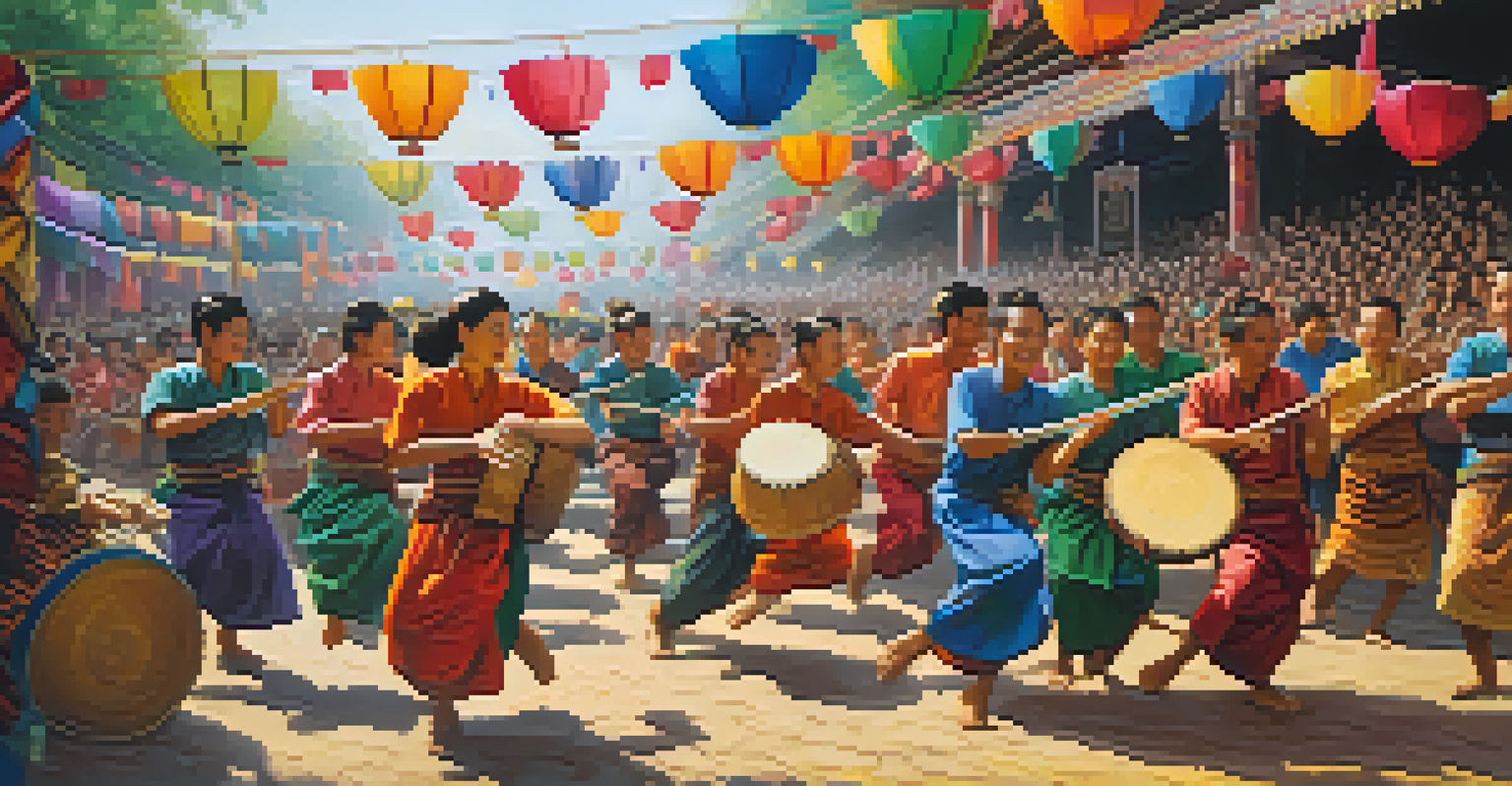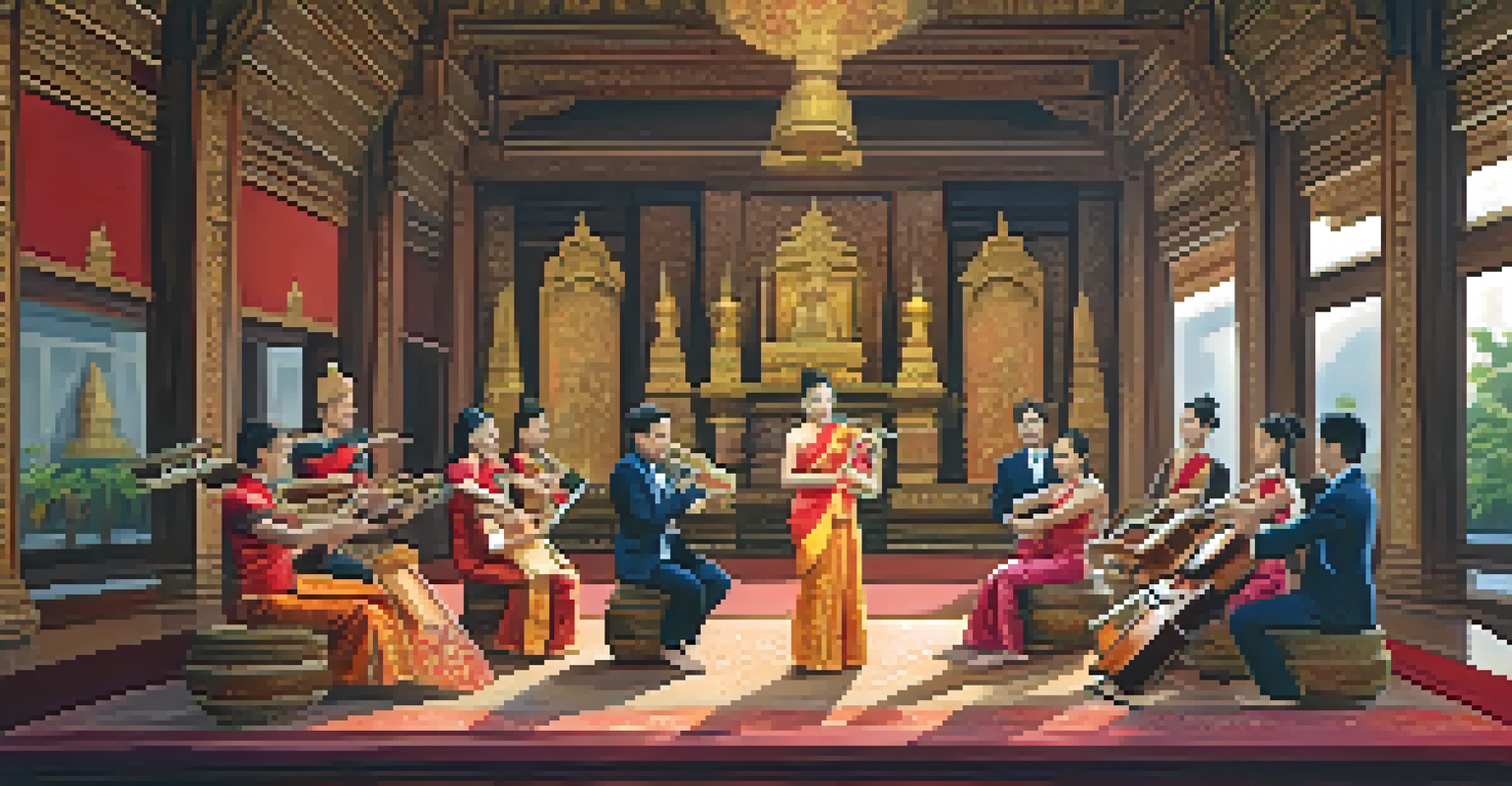The Influence of Regional Styles on Traditional Thai Music

Understanding Traditional Thai Music and Its Roots
Traditional Thai music is a vibrant reflection of the country's culture, blending influences from various regions. Each region of Thailand contributes unique musical elements, creating a beautiful tapestry of sounds. The roots of Thai music can be traced back to ancient times, where it served as a means of storytelling and cultural expression.
Music is the shorthand of emotion.
In essence, Thai music is divided into classical, folk, and contemporary styles, each reflecting the diverse backgrounds of the Thai people. Classical music often features intricate melodies played on traditional instruments, while folk music embraces the stories and experiences of local communities. This regional diversity is what makes Thai music so captivating and rich in history.
Moreover, the geographical landscape of Thailand, from mountains to rivers, has shaped the musical styles of different regions. For instance, the northern region is known for its unique string instruments and slower rhythms, while the southern region showcases lively percussion and faster tempos. Understanding these roots allows us to appreciate the depth and complexity of Thai music.
The Northern Region: Lanna Influence on Thai Music
The northern region of Thailand, known as Lanna, is famous for its distinct musical style that incorporates both Thai and Burmese influences. Instruments like the 'saw duang,' a two-stringed fiddle, and the 'klong chao,' a traditional drum, are central to this region's sound. Lanna music often features melodies that are slower and more contemplative, reflecting the serene landscapes of the north.

Festivals in this region, such as Yi Peng, showcase traditional music and dance, highlighting the importance of cultural heritage. During these celebrations, locals perform songs that tell stories of love, nature, and spirituality, connecting the community through shared experiences. This regional style truly embodies the spirit of Lanna.
Diverse Roots of Thai Music
Traditional Thai music is a rich blend of regional influences, showcasing unique styles from various parts of the country.
Additionally, Lanna's music is characterized by its unique vocal techniques, often involving chanting and call-and-response patterns. This creates an intimate atmosphere during performances, inviting audiences to participate and feel a sense of belonging. The influence of Lanna music on traditional Thai music is profound, highlighting the beauty of regional diversity.
Isan Region: The Heartbeat of Traditional Thai Folk Music
The Isan region of northeast Thailand is renowned for its lively folk music, heavily influenced by the Laotian culture. Instruments like the 'khaen,' a bamboo mouth organ, and the 'phin,' a lute-like string instrument, are essential in creating the energetic rhythms characteristic of this style. Isan music often features upbeat tempos that encourage dancing, making it a favorite at celebrations and gatherings.
Without music, life would be a mistake.
One of the most popular forms of Isan music is 'mor lam,' which combines storytelling with music, often addressing social issues and everyday life. This genre not only entertains but also educates listeners about their culture and challenges, fostering a sense of community. The catchy melodies and relatable lyrics draw people in, making Mor Lam a staple in Thai music.
Moreover, Isan music's influence extends beyond regional boundaries, impacting popular Thai music genres today. The fusion of traditional and contemporary styles showcases the adaptability of Isan music, ensuring its relevance in modern Thai society. This resilience illustrates how deeply rooted cultural expressions can thrive amidst change.
Central Thailand: The Elegance of Classical Thai Music
Central Thailand is the heartland of classical Thai music, known for its elegance and sophistication. This style is characterized by intricate melodies performed with traditional instruments like the 'ranat ek,' a wooden xylophone, and the 'khim,' a Thai hammered dulcimer. The music often accompanies classical dance performances, enhancing the overall aesthetic experience.
Classical Thai music is deeply tied to royal and religious ceremonies, reflecting its historical significance. The compositions are often highly structured, with specific rules governing rhythm and melody. This attention to detail elevates classical music to an art form, allowing musicians to express their skill and creativity.
Role of Festivals in Music
Festivals in Thailand are crucial for promoting regional music styles and fostering community pride through cultural celebrations.
Furthermore, the central region's music often serves as a bridge between tradition and modernity. Contemporary artists are increasingly blending classical elements with modern genres, creating a hybrid style that appeals to new audiences. This evolution of classical Thai music demonstrates its enduring relevance and adaptability.
Southern Thailand: The Rhythmic Pulse of Thai Music
The southern region of Thailand is known for its vibrant and rhythmic music, characterized by the use of various percussion instruments. Styles such as 'nang talung,' or shadow puppetry, incorporate music that complements the storytelling, adding depth to the performances. The fast-paced beats invite listeners to engage and dance, making southern music a lively experience.
Instruments like the 'tung' drum and 'ranat thum' add a unique flair to the southern sound, creating a rich auditory landscape. Southern music often reflects the daily lives and traditions of coastal communities, with themes revolving around the sea and local culture. The connection to the environment is evident in the music, creating a sense of place and identity.
Moreover, the southern region has seen a rise in contemporary genres that blend traditional sounds with modern influences. Artists are experimenting with pop and rock elements, showcasing the versatility of southern music. This fusion not only keeps the cultural heritage alive but also attracts younger generations, ensuring the continuation of these musical traditions.
The Role of Festivals in Promoting Regional Music Styles
Festivals in Thailand play a crucial role in celebrating and promoting regional music styles, providing a platform for artists to showcase their talents. Events like the Songkran Festival and the Loy Krathong Festival feature music and dance performances that highlight the cultural diversity across the country. These gatherings bring communities together, fostering a sense of pride and continuity in their musical heritage.
During these festivals, locals and tourists alike can experience the rich variety of Thai music, from the intricate melodies of classical performances to the energetic rhythms of folk music. This exposure not only entertains but also educates attendees about the different regional styles, creating a greater appreciation for Thailand's musical landscape.
Globalization's Impact on Music
The influence of globalization presents both challenges and opportunities for traditional Thai music, prompting a balance between innovation and preservation.
Moreover, festivals serve as a space for collaboration among musicians from different regions, encouraging the fusion of styles and innovation. This exchange of ideas and techniques enriches the overall music scene in Thailand, ensuring that traditional elements continue to evolve. The celebration of regional music through festivals is essential for preserving and promoting Thailand's rich cultural heritage.
The Influence of Globalization on Thai Music Styles
As Thailand becomes more interconnected with the global community, its music is influenced by a variety of international styles. This globalization presents both opportunities and challenges for traditional Thai music. While some artists blend Western genres with traditional elements, others strive to preserve the authenticity of their regional styles amidst these changes.
The rise of digital platforms has made it easier for Thai musicians to share their work with a global audience, widening the scope of their influence. Genres like Thai pop, or 'T-pop,' often incorporate elements from hip-hop and electronic music, attracting younger listeners while still paying homage to traditional roots. This blend of styles allows for a dynamic musical landscape that reflects the evolving identity of Thai culture.

However, there is a growing concern about the potential loss of traditional music as globalization continues to reshape the industry. Musicians and cultural advocates are working to strike a balance between embracing modern influences and preserving the integrity of regional styles. This dialogue between tradition and innovation is crucial for the future of Thai music.
Preserving Traditional Thai Music: A Cultural Responsibility
Preserving traditional Thai music is not just an artistic endeavor; it is a cultural responsibility. As globalization and modernization continue to influence musical landscapes, there is a risk of losing the unique sounds and stories embedded in regional styles. Efforts to document and promote these traditions are essential for the next generation to appreciate and carry forward.
Educational programs and workshops focused on traditional instruments and music styles are vital in fostering a new wave of musicians. By engaging young people in these art forms, we ensure that the rich heritage of Thai music is passed down and revitalized. This cultural transmission helps maintain the diversity and richness of Thailand's musical identity.
Moreover, community initiatives and local performances play a significant role in keeping traditional music alive. By supporting local artists and attending performances, we contribute to the sustainability of regional styles. Ultimately, the preservation of traditional Thai music is a shared responsibility that requires collective effort from both artists and audiences.